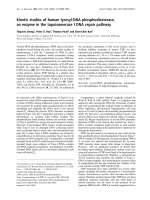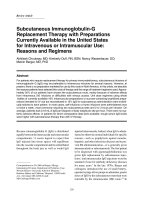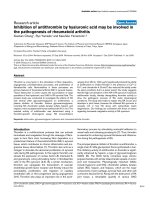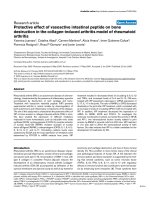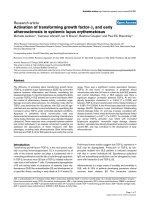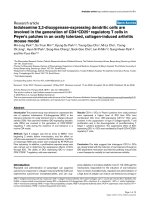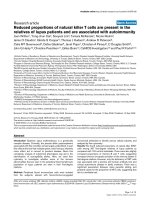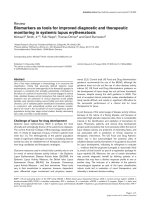Báo cáo y học: " Subjective memory complaints, vascular risk factors and psychological distress in the middle-aged: a cross-sectional study" pptx
Bạn đang xem bản rút gọn của tài liệu. Xem và tải ngay bản đầy đủ của tài liệu tại đây (203.5 KB, 7 trang )
RESEARC H ARTIC LE Open Access
Subjective memory complaints, vascular risk factors
and psychological distress in the middle-aged:
a cross-sectional study
Matt B Paradise
1*
, Nick S Glozier
1
, Sharon L Naismith
1
, Tracey A Davenport
2
and Ian B Hickie
1
Abstract
Background: Subjective memory complaints (SMC) are common but their significance is still unclear. It has been
suggested they are a precursor of mild cognitive impairment (MCI) or dementia and an early indicator of cognitive
decline. Vascular risk factors have an important role in the development of dementia and possibly MCI. We
therefore aimed to test the hypothesis that vascular risk factors were associated with SMC, independent of
psychological distress, in a middle-aged community-dwelling population.
Methods: A cross-sectional analysis of baseline data from the 45 and Up Study was performed. This is a cohort
study of people living in New South Wales (Australia), and we explored the sample of 45, 532 participants aged
between 45 and 64 years. SMC were defined as ‘fair’ or ‘poor’ on a self-reported five-point Likert scale of memory
function. Vascular risk factors of obesity, diabetes, hypertension, hypercholesterolemia and smoking were identified
by self-report. Psycholog ical distress was measured by the Kessler Psychological Distress Scale. We tested the
model generated from a randomly selected exploratory samp le (n = 22, 766) with a confirmatory sample of equal
size.
Results: 5, 479/45, 532 (12%) of respondents reported SMC. Using multivariate logistic regression, only two vascu lar
risk factors: smoking (OR 1.1 8; 95% CI = 1.03 - 1.35) and hypercholesterolaemia (OR 1.19; 95% CI = 1.04 - 1.36)
showed a small independent association with SMC. In contrast psychological distress was strongly associated with
SMC. Those with the highest levels of psychological distress were 7.00 (95% CI = 5.41 - 9.07) times more likely to
have SMC than the non-distressed. The confirmatory sample also demonstrated the strong association of SMC with
psychological distress rather than vascular risk factors.
Conclusions: In a large sample of middle-aged people without any history of major affective illness or stroke,
psychological distress was strongly, and vascular risk factors only weakly, associated with SMC, alth ough we cannot
discount psychological distress acting as a mediator in any association between vascular risk factors and SMC.
Given this, clinicians should be vigilant regarding the presence of an affective illness when assessing middle-aged
patients presenting with memory problems.
Background
Subjective memory complaints (SMC) are common and
strongly associated with age. Estimates of their commu-
nity prevalence have ranged from 11% [1] in 65 to 85
year olds to over 88% in those over the age of 85 years
[2]. In Australia, Jorm et al. [3] found a prevalence of
10% in those with an average age of 62 years. There is
uncertainty regarding the significance of SMC. They may
be an early marker of cognitive decline with an underly-
ing pathological basis, a feature of normal ageing and/or
a reflection of psychological distress.
Cross-sectional studies have not consistently found an
independent association between SMC and objective cog-
nitive impairment [4]. In contrast, longitudinal studies
have reported a strong association between SMC and the
subsequent development of dementia or cognitive decline
over periods of one to seven years [4-7]. Support for t he
pathological basis of SMC is further supported by rece nt
* Correspondence:
1
Brain & Mind Research Institute, The University of Sydney, Building F, 94
Mallet Street, Camperdown, NSW 2050, Australia
Full list of author information is available at the end of the article
Paradise et al. BMC Psychiatry 2011, 11:108
/>© 2011 Paradise et al; licensee BioMed Central Ltd. This is an Open Access article distributed under the terms of the Cr eative Commons
Attribution License (http://c reativecommons.org/licenses/by/2.0), which permits unrestricted us e, distribution, and reproduction in
any medium, provided the original work is properly cited.
neuroimaging studies, which have reported that euthymic
individuals with memory complaints, free from signifi-
cant objective deficits have early signs of Alzheimer’s Dis-
ease (AD) pathology on MRI, such as medial-temporal
lobe atrophy [8,9].
Vascular risk factors such as diabetes, smoking, obe-
sity, hypertension and hypercholesterolaemia are well
established as risk factors in the development of demen-
tia [10,11] and MCI [12-15]. The e xact mechanism for
this is unclear, but there is considerable interest in the
vascular hypothesis of AD, where vascular risk factors
lead to cerebr al hypoperfusion and later neurod egenera-
tion [16]. To our knowledge only two studies, both
cross-sectional, have examine d the relations hip between
vascular risk factors and SMC, with conflicting results
[3,17]. Neither of these studies examined the SMC-vas-
cular risk factor association as their primary analysis.
There is also a strong a ssoci ation between SMC and
depression [18-20], such that several studies have
reported that after adjustment for mood, there is no
longer an association of SMC with objective memory
deficits [3,20,21]. There is also an association between
vascular risk factors and depression [22,23] and indeed
cerebrovascular disease in depression is predictive of
poor prognosis a nd progression to dementia [24]. Any
observed relationship bet ween vascular risk factors and
SMC may therefor e be confounded/mediated by depres-
sion. Identification of the relative contributi on of vascu-
lar risk factors and depression as potentially modifiable
determinants of SMC in older people may enable early
intervention strategies to pr event subsequent cognitive
decline [25] and dementia, guiding both primary and
secondary prevention approaches [25].
The objective of t his study is to examine the assoc ia-
tions between SMC, vascular risk factors and psycholo-
gical distress. Our hypothesis is that vascular risk factors
will be associated with SMC. Further, that this associa-
tion will be independent of psychological distress.
Methods
We used data from the 45 and Up Study [26], a very
large study of healthy ageing, in the state of New South
Wales (NSW), Australia. As detailed elsewhere [26], par-
ticipants w ere recruited through the Medicare Australia
enrolment database, which provides almost complete
coverage of the general population. Eligible individuals
were mailed an invitation to take part, an information
leaflet, the study questionnaire, a c onsent form and a
reply paid envelope. The participation rate of the 45 and
Up Study was approximately 18% for the first 100, 000
participants [26]. We gained permission from The Sax
Institute to use data from the 45 and Up Study dataset
and ethical approval had been granted from the relevant
ethics committees.
We limited our cohort to those aged between 45 and
64 years t o reflect the early intervention approach [25].
Additionally, by limiting the sample to this age-range
we attempted to minimise the chances that the sample
would include people with pre-existing dementia. For
theinitialanalysis,wealsoexcludedthosewhohad
reported having been diagnosed with a stroke or
receiving psychiatric medication for depression or
anxiety, because of the known cognitive sequelae of
these conditions [27].
The 45 and Up Study questionnaire
All measures were extracted f rom the 45 and Up Study
questionnaire [see 28]. This contained questions about
demographic information, vascular risk factors and psy-
chological distress.
Age was grouped into five-year intervals (i.e. 45-49
years, 50-54 years, 55- 59 years, 60-64 years) and educa-
tion was grouped into three levels ( low, medium, high),
according to both a priori assumptions and observations
of their odds ratios. The three education levels were
determined by whether the individual had left school
early without a leaving certificate, had completed high
school or had gone on to attain tertiary qualifications.
Five vascular risk factors were able to be considered;
thepresenceofobesity,diabetes, whether the person
was a current smoker and whether the individual was
currently being treated for hypertension or hypercholes-
terolaemia. Obesity was defined as a Body Mass Index
(BMI) greater than or equal to 30, according to World
Health Organisation standards. The BMI was i mputed
using the weight and height recorded [29]. The presence
of diabetes was determined by th e question; “Has a doc-
tor EVER told you that you have diabetes?”. The parti-
cipant’s smoking status was determined by the question
“Are you are regular smoker now?” Treatment for hyper-
tension and hypercholesterolaemia were determined by
the questions “In the last month have you been tr eated
for high blood pressure?” and “ high blood cholesterol?“
Psychological distress was assessed by the 10-item
Kessler Psychological Distress Scale (K10) [30], which
provides a global measure of distress based on depres-
sive and anxiety symptoms experienced in the last four
weeks. The cut-off scores were based on the ‘Clinical
Research Unit for Anxiety and Depression’ levels [31]
and have been validated by the Australian Bureau of
Statistics [32,33]. Each item was scored from 1 for ’none
of the time’ to 5 for ’all of the time’. Scores for the ten
items were then summed, yielding a minimum possible
score of 10 and a maximum possible score of 50. Low
scores of 10-15 indicate low levels of psychological dis-
tress, scores ranging from 16-29 ‘moderate’ levels of psy-
chological distress and high scores of 30-50 indicate
‘severe’ levels of psychological distress.
Paradise et al. BMC Psychiatry 2011, 11:108
/>Page 2 of 7
The primary outcome variable of SMC was identified
using a five-point Li kert scale in which par ticipants
were asked “In general, how would you rate your mem-
ory?”, with a choice of the following responses ‘1 - poor’,
‘ 2-fair’ , ‘3 - good’ , ‘4 - very good’ or ‘5 - excellent’ .
Those rating their memory as ‘ fair’ or ‘ poor’ were
defined as experiencing SMC. This approach and cut-off
point is consistent with previous studies that have exam-
ined SMC [34,35].
Statistical analyses
All data w ere analysed using the Statistical Package for
the Social Sciences (SPSS 17.0 for Windows, Chicago,
USA). Only those participants with full data were
included in the statistical analyses.
We generated baseline characteristics of the 45, 532
participants. Two univariate analy ses were run. Firstly,
we examined the associa tions between demographic
information, vascular risk factors and psychological dis-
tress with SMC. We then analysed the association
between vascular risk factor s and psychological distress.
For dichotomous and categorical variables, odds-ratios
of their association with SMC were produced. High edu-
cationwasusedasthereference group based on the a
priori assumption that lower education would be asso-
ciated with SMC.
The SPSS Random Number Generator was used to
create two separate datasets of equal size (n = 22, 766)
for exploratory and confirmatory model analyses. Chi-
squared tests were used to determine if there was any
significant difference in demographic information, vas-
cular risk factors or psychological distress between the
exploratory and confirmatory samples.
All variables were then entered into exploratory logis-
tic regression analyses, using the ‘enter’ method. There
were four models generated. Model 1 considered demo-
graphic variables. Model 2 used demographic variables
and the measure of psychological distress. Model 3
included demographic variables and vascular risk fac-
tors. The final model, Model 4, included demographic
variables, vascular risk factors and a measur e of psycho-
logical distress.
Finally, based on sound statistical results and apriori
hypotheses, Model 4 was considered to be the most
robust and was subsequently imposed on the confirma-
tory dataset to test its validity. For a ll analyses, we took
the conservative approach of setting the significance
level at p < 0.001, to reduce the chance of a Type-1
error given our large sample size.
Results
Of the 103, 041 total respondents, 55, 685 were aged
less than 65 years and had not had a stroke or received
treatment for depression and anxiety within the last
month. Of th ese, 45, 533 participants had complete data
available for all variables.
Demographic, vascular risk factor and psychological
distress characteristics are shown in Table 1. S MC were
strongly associated with low education and male gender,
the presence of diabetes, being a current smoker and
receiving treatment for hypercholesterolaemia. Obesity
and receiving treatment of hypertension were not asso-
ciated with SMC. Psychological distress had the stron-
gest association with SMC. Those with the greatest
psychological distress (i.e. K10 category of ‘severe’)had
an odds ratio of 7.68 (95% CI = 6.38 - 9.24) of having
SMC compared to those with the least psychological
distress.
Table 2 shows the association of v ascular risk factors
with psychological distress. Obesity, diabetes, being a
current smoker and receiving treatment for hypercholes-
terolaemia were associated with psychological distress.
There were no significant differences in any of the
baseline characteristics between the exploratory and
confirmato ry samples. Table 3 shows Models 1, 2, 3 and
4 of the multivariate analysis generated with the
exploratory sample. Model 1 demonstrates that male
gender and low education, but not age, were associated
with SMC. These results were not attenuated by the
presence of psychological distress in Model 2, which
was strongly associated with SMC. Model 3 demon-
strates that once adjusted for demographic variables, the
only factor vascular risk factor that remained signifi-
cantly associated with SMC in our conservative
approach was being a current smoke r (being treated for
hypercholesterolaemia and diabetes both showed a trend
towards association with SMC; p = 0.002). When
adjusted for the presence of psychological distress in
Model 4, the association between vascular risk factor
and SMC further weakened, such that even in this very
large sample, there were no statistically significant asso-
ciations at the p < 0.001 level although both being a
current smoker and hypercholesterolaemia treatment
were associated at standard levels of significance. In all
analyses, psychological distress had the strongest asso-
ciation with SMC. When fully adjusted, those with
‘severe’ psychol ogical distress still had 7.00 times the
odds (95% CI = 5.41 - 9.07) of SMC.
The final Model 4 was imposed on into the confirma-
tory sample of 22, 766. This confirmed that male gender
(OR 1.30; 95% CI = 1.19 - 1.41) and low education (OR
1.68; 95% CI = 1.51 - 1.88) were associated with SMC,
but age was not. As seen in the exploratory dataset, in
the presence of both demographic variables and psycho-
logical distress, no vascular risk factors were associated
with SMC. Severe psychological distress was again
strongly associated with SMC with a similar odds ratio
of 6.86 (95% CI = 5.20 - 9.05).
Paradise et al. BMC Psychiatry 2011, 11:108
/>Page 3 of 7
Table 1 Characteristics of the 45 and Up Study sample and association of variables with SMC, N = 45, 532
Total SMC
(n, column %)
No SMC
(n, column %)
Odds ratio (95% CI)
N 45, 532 5, 479 (12.0%) 40, 053 (88.0%)
Demographics
Age
-45 to 49 years 9, 582 1, 152 (21.0%) 8, 430 (21.0%) 1.00
-50 to 54 years 12, 237 1, 441 (26.3%) 10, 796 (27.0%) 0.98 (0.90 - 1.06)
-55 to 59 years 12, 712 1, 510 (27.6%) 11, 202 (28.0%) 0.99 (0.91 - 1.07)
-60 to 64 years 11, 001 1, 376 (25.1%) 9, 625 (24.0%) 1.05 (0.96 - 1.14)
Gender
-Male 20, 606 2, 674 (48.8%) 17, 932 (44.8%) 1.18 (1.11 - 1.24)*
-Female 24, 926 2, 805 (51.2%) 22, 121 (55.2%)
Education
-High 13, 743 1, 071 (19.5%) 12, 672 (31.6%) 1.00
-Medium 19, 856 2, 462 (44.9%) 17, 394 (43.4%) 1.68 (1.55 - 1.81)*
-Low 11, 933 1, 946 (35.5%) 9, 987 (24.9%) 2.31 (2.13 - 2.50)*
Vascular risk factors
Obesity 10, 147 1, 306 (23.8%) 8, 841 (22.1%) 1.11 (1.03 - 1.18)
-non-obesity 35, 385 4, 173 (76.2%) 31, 212 (77.9%)
Diabetes 2, 475 379 (6.9%) 2, 096 (5.2%) 1.35 (1.20 - 1.51)*
-no diabetes 43, 057 5, 100 (93.1%) 37, 957 (94.8%)
Current smoker 3, 928 607 (11.1%) 3, 321 (8.3%) 1.38 (1.26 - 1.51)*
-non-smoker 41, 604 4, 872 (88.9%) 36, 732 (91.7%)
Treatment for hypertension 7, 338 928 (16.9%) 6, 410 (16.0%) 1.07 (0.99 - 1.15)
-no treatment for hypertension 38, 194 4, 551 (83.1%) 33, 643 (84.0%)
Treatment for hypercholesterolaemia 4, 892 692 (12.6%) 4, 200 (10.5%) 1.23 (1.13 - 1.35)*
-no treatment for hypercholesterolaemia 40, 640 4, 787 (87.4%) 35, 853 (89.5%)
Psychological distress
K10-low level of distress 35, 713 3, 139 (57.3%) 32, 574 (81.3%) 1.00
- moderate level of distress 9, 344 2, 138 (39.0%) 7, 206 (18.0%) 3.08 (2.90 - 3.27)*
- severe level of distress 475 202 (3.7%) 273 (0.7%) 7.68 (6.38 - 9.24)*
Note: * p < 0.001.
Table 2 Association of vascular risk factors with psychological distress, N = 45, 532
Level of psychological distress - K10
Vascular risk factors N n (%) Chi-square
Low Moderate Severe
Obesity 10, 147 7, 629 (75.2%) 2, 363 (23.3%) 155 (1.5%) 95.61*
-non-obesity 35, 385 28, 084 (79.4%) 6, 981 (19.7%) 320 (0.9%)
Diabetes 2, 475 1, 821 (73.6%) 599 (24.2%) 55 (2.2%) 60.03*
-no diabetes 43, 057 33, 892 (78.7%) 8, 745 (20.3%) 420 (1.0%)
Current smoker 3, 928 2, 752 (70.1%) 1, 065 (27.1%) 111 (2.8%) 260.39*
-non-smoker 41, 604 32, 961 (79.2%) 8, 279 (19.9%) 364 (0.9%)
Treatment for hypertension 7, 338 5, 653 (77.0%) 1, 607 (21.9%) 78 (1.1%) 10.30
-no treatment for hypertension 38, 194 30, 060 (78.7%) 7, 737 (20.3%) 397 (1.0%)
Treatment for hypercholesterolaemia 4, 892 3, 731 (76.3%) 1, 098 (22.4%) 63 (1.3%) 16.30*
-no treatment for hypercholesterolaemia 40, 640 31, 892 (78.7%) 8, 246 (20.3%) 412 (1.0%)
Note: *p < 0.001.
Paradise et al. BMC Psychiatry 2011, 11:108
/>Page 4 of 7
Discussion
In an Australian community sample of 45 to 64 year
olds, who are not currently receiving treatment for
depression or anxiety and who are unlikely to have sig-
nificant cognitive impairm ent, SMC are common, with a
prevalence of 12%. In univariate analysis, the vascular
risk factors of diabetes, being a current smoker and
treatment for hypercholesterolaemia were associated
with SMC. In multivariate analyses, when adjusted for
psychological distress and demographics, vascular risk
factors showed only weak associations with SMC This
may be be cause of the confounding effect of gender and
education, with post-hoc analyses showing male gender
and less education were strongly associated with the
presence of vascular risk factors.
The lack of strong association of vascular risk factors
with SMC is consistent with Jorm et al. [3], who reported
that diabetes, ‘ heart troubles’ and a history of strokes
were not associated with memory complaints in multi-
variate analysis, in an Australian sample of community-
dwelling 60 to 64 years old with generally good cognition.
This is also consistent with Stewart et al. [17] who found
that in an Afro-Caribbean population hypertension, dia-
betes, electrocardiography-defined ischemia, cholesterol
or triglyceride levels were not associated with memory
complaints (although having had a stroke was a signifi-
cant risk).
In contrast to vascular risk factors, there was a strong
independent association between psychological distress
andSMC.Thisisconsistentwithotherliterature
[18-20] and m ay reflect the common depressive symp-
toms of poor memory and concentration. There may
also be a tendency in subjects with significant psycholo-
gical distress to have a negative attribution bias and
therefore over-report memory comp laints [36]. Memory
complaints in those with high levels of psychological
distress may also represent a common underlying patho-
physiology. Depression, for example is now recognised
as an independent modifiable risk-factor for cognitive
decline [37] and conversion of MCI to dementia [38].
Several mechanisms have been postulated for this rela-
tionship including the neurotoxic effects of chronic
hypercortisolaemia, reduced levels o f neurotrophic fac-
tors [39], alterations in glial-neuronal networks, vascular
disease and inflammatory processes [40]. Indeed, older
patients with depression have reduced hippocampal size,
which in turn, is associated with poorer memory [40].
Our data shows a strong association between vascular
risk and psychological distress. This is consistent with
the literature, where the association between vascular
Table 3 Multivariate models of associations of SMC using the exploratory sample, N = 22, 766
Model 1 Model 2 Model 3 Model 4
Odds ratio (95% CI) Odds ratio (95% CI) Odds ratio (95% CI) Odds ratio (95% CI)
Demographics
Age
-45 to 49 years 1.00 1.00 1.00 1.00
-50 to 54 years 0.97 (0.86 - 1.09) 1.01 (0.90 - 1.14) 0.97 (0.86 - 1.09) 1.01 (0.90 - 1.15)
-55 to 59 years 0.96 (0.85 - 1.08) 1.09 (0.96 - 1.22) 0.96 (0.85 - 1.08) 1.08 (0.96 - 1.22)
-60 to 64 years 0.95 (0.85 - 1.08) 1.09 (0.99 - 1.23) 0.95 (0.84 - 1.07) 1.08 (0.95 - 1.22)
Gender
-Male 1.26 (1.16 - 1.36)* 1.29 (1.18 - 1.40)* 1.23 (1.13 - 1.34)* 1.27 (1.17 - 1.40)*
Education
-High 1.00 1.00 1.00 1.00
-Medium 1.62 (1.46 - 1.80)* 1.59 (1.43 - 1.77)* 1.59 (1.43 - 1.77)* 1.58 (1.42 - 1.76)*
-Low 2.22 (1.98 - 2.48)* 2.06 (1.84 - 2.31)* 2.14 (1.91 - 2.40)* 2.03 (1.81 - 2.28)*
Vascular risk factors
Obesity 0.98 (0.89 - 1.08) 0.94 (0.85 - 1.03)
Diabetes 1.21 (1.03 - 1.43) 1.13 (0.96 - 1.34)
Current smoker 1.31 (1.15 - 1.49)* 1.18 (1.03 - 1.35)
Treatment for hypertension 0.97 (0.86 - 1.09) 0.96 (0.85 - 1.08)
Treatment for hypercholesterolaemia 1.22 (1.07 - 1.39) 1.19 (1.04 - 1.36)
Psychological distress
K10-low level of distress 1.00 1.00
- moderate level of distress 2.96 (2.71 - 3.23)* 2.94 (2.69 - 3.21)*
- severe level of distress 7.21 (5.57 - 9.32)* 7.00 (5.41 - 9.07)*
Notes: *p < 0.001; Model 1 - demographic variables; Model 2 - demographic variables and psychological distress; Model 3 - demographic variables and vascular
risk factors; Model 4 - demographic variables, vascular risk factors and psychological distress.
Paradise et al. BMC Psychiatry 2011, 11:108
/>Page 5 of 7
risk factors and depression is well documented [23]. We
hypothesised that psychological distress might mediate
any relationship between vascular risk factors and SMC.
However, the general lack of associations between vas-
cular risk factors and SMC seen in Model 3 would sug-
gest that any such mediation is minimal. Further
exploration of these complex relationships is warranted
in longitudinal studies.
There are sev eral strengths of this study. It is the lar-
gest study to date that examines the relationship
between psychological distress, vascular risk factors and
SMC. The questi ons were all taken from validated ques-
tionnaires used extensively in Australian populations.
Our finding of a SMC prevalence of 12% is consistent
with the community samples from the literature [1,3].
The major limitation of this study is the uncertainty
regarding the direction of causality of any observed asso-
ciation: for example, it may be that SMC lead to psycholo-
gical distress, rather than the other way around. We also
cannot correlate the measure of SMC with an objective
cognitive assessment. We could not specifically exclude
cases of dementia or MCI although by limiting the cohort
to t hose aged less than 65, we are unlik ely to have many
cases. A recent meta-analysis found a dementia prevalence
rate of 0.6% for those aged between 60 and 64 years in
Australasia [41]. Also, the ability to complete, sign and
return the questionnaire would exclude those with signifi-
cant cognitive decline. In any event, as seen with stroke,
these cases may be unlikely to d ramatically affect the
results.
The presence of hypertension and hypercholesterolae-
mia were determined by the prescription of medication
for these conditions. There may therefore be undetected
individuals with these vascular risk factors and those
receiving treatme nts for these conditions may parado xi-
cally be at a reduced risk.
Finally, there is the effect of the size of the study. Ana-
lyses of such large samples may result in T ype I errors.
Such studies always result in a trade-off between efficiency
and the diminution of measurement errors in a large sam-
ple against the ability of such measures to provide valid eva-
luations at an individual level. Although we do not
anticipate any significant bias in the response, the error will
serve to reduce the observed estimate of the association.
The similar results found in the exploratory and confirma-
tory datasets strengthen the validity of our conclusions.
All our measures are self-report and as such, our
exposure may be subject to information bias, with those
people reporting SMC potentially being less likely to
recall the presenc e of vascular risk factors. This would
lead us to have underestimated any real association
between vascular risk factors and SMC.
The participation rate of the 45 and Up Study was
low, at 18% for the first 100, 000 participant s. Alt hough
this raises questions about the representativ eness of the
sample, comparison with the NSW P opulation Health
Survey demonstrated good generalisability [42].
Conclusions
SMC are common in community-dwelling middle-aged
adults without any history of major affective illness or
stroke. Vascular risk factors were not independently asso-
ciated with S MC. Psychological distress was highly asso-
ciated with SMC as well as with vascular risk factors.
This finding adds some support to the concept of vas-
cular depression [43] and empha sises the need for clini-
cians to take SMC seriously in their patients, as a
common indicator of undetected psychological distress
and possible affective illness. This may best be achieved
through primary care education programmes highlight-
ing early detection and management of psychological
distress in at-risk groups [44,45].
The complex relationship between memory complaints,
vascular risk and psychological distress needs further
exploration in longitudinal studies. A greater understand-
ing of SMC may allow early i nter vention to prevent psy-
chological dis tress and potentially modify cognitive d ecline.
Acknowledgements
The 45 and Up Study is managed by The Sax Institute in collaboration with
major partner Cancer Council New South Wales; and partners the National
Heart Foundation of Australia (NSW Division); NSW Health; beyondblue: the
national depression initiative; Ageing, Disability and Home Care, Department
of Human Services NSW; and UnitingCare Ageing.
Dr Paradise, A/Prof Naismith and Prof Hickie and are funded by an NHMRC
Australia Fellowship awarded to Prof Hickie.
Author details
1
Brain & Mind Research Institute, The University of Sydney, Building F, 94
Mallet Street, Camperdown, NSW 2050, Australia.
2
Academic Research &
Statistical Consulting, 5 Herbert Street, West Ryde, NSW 2114, Australia.
Authors’ contributions
MBP conceived the study and wrote the first draft. NSG helped with the
study design, statistics and editing the manuscript. SLN provided input into
the study design and helped draft the manuscript. TAD provided statistical
advice and helped edit the manuscript. IBH provided overall supervision for
the project and helped draft the manuscript. All authors read and approved
the final manuscript.
Competing interests
The authors declare that they have no competing interests.
Received: 16 February 2011 Accepted: 1 July 2011
Published: 1 July 2011
References
1. Geerlings MI, Jonker C, Bouter LM, Ader HJ, Schmand B: Association
between memory complaints and incident Alzheimer’s disease in elderly
people with normal baseline cognition. Am J Geriatr Psychiatry 1999,
156(4):531-537.
2. Larrabee GJ, Crook TH: Estimated prevalence of age-associated memory
impairment derived from standardized tests of memory function. Int
Psychogeriatr 1994, 6(1):95-104.
3. Jorm AF, Butterworth P, Anstey KJ, Christensen H, Easteal S, Maller J,
Mather KA, Turakulov RI, Wen W, Sachdev P: Memory complaints in a
Paradise et al. BMC Psychiatry 2011, 11:108
/>Page 6 of 7
community sample aged 60-64 years: associations with cognitive
functioning, psychiatric symptoms, medical conditions, APOE genotype,
hippocampus and amygdala volumes, and white-matter
hyperintensities. Psychol Med 2004, 34(8):1495-1506.
4. Reid LM, Maclullich AMJ: Subjective memory complaints and cognitive
impairment in older people. Dement Geriatr Cogn Disord 2006, 22(5-6):471-485.
5. Jessen F, Wiese B, Bachmann C, Eifflaender-Gorfer S, Haller F, Kolsch H,
Luck T, Mosch E, van den Bussche H, Wagner M, Wollny A, Zimmermann T,
Pentzek M, Riedel-Heller SG, Romberg H-P, Weyerer S, Kaduszkiewicz H,
Maier W, Bickel H: Prediction of dementia by subjective memory
impairment: effects of severity and temporal association with cognitive
impairment. Arch Gen Psychiatry 67(4):414-422.
6. Jonker C, Geerlings MI, Schmand B: Are memory complaints predictive for
dementia? A review of clinical and population-based studies. Int J Geriatr
Psychiatry 2000, 15(11):983-991.
7. Reisberg B, Prichep L, Mosconi L, John ER, Glodzik-Sobanska L, Boksay I,
Monteiro I, Torossian C, Vedvyas A, Ashraf N, Jamil IA, de Leon MJ: The pre-
mild cognitive impairment, subjective cognitive impairment stage of
Alzheimer’s disease. Alzheimers Dement 2008, 4(1 Suppl 1):S98-S108.
8. Saykin AJ, Wishart HA, Rabin LA, Santulli RB, Flashman LA, West JD,
McHugh TL, Mamourian AC: Older adults with cognitive complaints show
brain atrophy similar to that of amnestic MCI. Neurology 2006, 67(5):834-842.
9. Chao LL, Mueller SG, Buckley ST, Peek K, Raptentsetseng S, Elman J, Yaffe K,
Miller BL, Kramer JH, Madison C, Mungas D, Schuff N, Weiner MW: Evidence
of neurodegeneration in brains of older adults who do not yet fulfill
MCI criteria. Neurobiol Aging 2008, 31(3):368-377.
10. Luchsinger JA, Reitz C, Honig LS, Tang MX, Shea S, Mayeux R: Aggregation
of vascular risk factors and risk of incident Alzheimer disease. Neurology
2005, 65(4):545-551.
11. Gorelick PB: Risk factors for vascular dementia and Alzheimer disease.
Stroke 2004, 35(11 Suppl 1):2620-2622.
12. Kivipelto M, Helkala EL, Hanninen T, Laakso MP, Hallikainen M, Alhainen K,
Soininen H, Tuomilehto J, Nissinen A: Midlife vascular risk factors and
late-life mild cognitive impairment: A population-based study. Neurology
2001, 56(12):1683-1689.
13. Solfrizzi V, Panza F, Colacicco AM, D’Introno A, Capurso C, Torres F,
Grigoletto F, Maggi S, Del Parigi A, Reiman EM, Caselli RJ, Scafato E,
Farchi G, Capurso A: Vascular risk factors, incidence of MCI, and rates of
progression to dementia. Neurology 2004, 63(10):1882-1891.
14. Ravaglia G, Forti P, Maioli F, Martelli M, Servadei L, Brunetti N, Pantieri G,
Mariani E: Conversion of mild cognitive impairment to dementia:
predictive role of mild cognitive impairment subtypes and vascular risk
factors. Dement Geriatr Cogn Disord 2006, 21(1):51-58.
15. Mariani E, Monastero R, Ercolani S, Mangialasche F, Caputo M, Feliziani FT,
Vitale DF, Senin U, Mecocci P, Re GSG: Vascular risk factors in mild
cognitive impairment subtypes. Findings from the ReGAl project.
Dement Geriatr Cogn Disord 2007, 24(6):448-456.
16. de la Torre JC: Is Alzheimer’s disease a neurodegenerative or a vascular
disorder? Data, dogma, and dialectics. Lancet Neurol 2004, 3(3):184-190.
17. Stewart R, Russ C, Richards M, Brayne C, Lovestone S, Mann A: Depression,
APOE genotype and subjective memory impairment: a cross-sectional
study in an African-Caribbean population. Psychol Med 2001, 31(3):431-440.
18. Tobiansky R, Blizard R, Livingston G, Mann A: The Gospel Oak Study stage
IV: the clinical relevance of subjective memory impairment in older
people. Psychol Med 1995, 25(4):779-786.
19. Hanninen T, Reinikainen KJ, Helkala EL, Koivisto K, Mykkanen L, Laakso M,
Pyorala K, Riekkinen PJ: Subjective memory complaints and personality
traits in normal elderly subjects. J Am Geriatr Soc 1994, 42(1):1-4.
20. Minett TSC, Dean JL, Firbank M, English P, O’Brien JT: Subjective memory
complaints, white-matter lesions, depressive symptoms, and cognition
in elderly patients. Am J Geriatr Psychiatry 2005, 13(8):665-671.
21. Minett TSC, Da Silva RV, Ortiz KZ, Bertolucci PHF: Subjective memory
complaints in an elderly sample: a cross-sectional study. Int J Geriatr
Psychiatry 2008, 23(1):49-54.
22. Hickie I, Scott E, Mitchell P, Wilhelm K, Austin MP, Bennett B: Subcortical
hyperintensities on magnetic resonance imaging: clinical correlates and
prognostic significance in patients with severe depression. Biol Psychiatry
1995, 37(3):151-160.
23. Hickie I, Scott E: Late-onset depressive disorders: a preventable variant of
cerebrovascular disease? Psychol Med 1998, 28(5):1007-1013.
24. Hickie I, Scott E, Wilhelm K, Brodaty H: Subcortical hyperintensities on
magnetic resonance imaging in patients with severe depression–a
longitudinal evaluation. Biol Psychiatry 1997, 42(5):367-374.
25. Naismith SL, Glozier NS, Burke D, Carter PE, Scott E, Hickie IB: Early
intervention for cognitive decline: is there a role for multiple medical or
behavioural interventions? Early Interv Psychiatry 2009, 3:19-27.
26. Banks E, Redman S, Jorm L, Armstrong B, Bauman A, Beard J, Beral V, Byles J,
Corbett S, Cumming R, Harris M, Sitas F, Smith W, Taylor L, Wutzke S, Lujic S:
Cohort profile: the 45 and up study. Int J Epidemiol 2008, 37(5):941-947.
27. Naismith SL, Hickie IB, Turner K, Little CL, Winter V, Ward PB, Wilhelm K,
Mitchell P, Parker G: Neuropsychological performance in patients with
depression is associated with clinical, etiological and genetic risk factors.
J Clin Exp Neuropsychol 2003, 25(6):866-877.
28. The 45 and Up Study.
[].
29. WHO: Technical report series 894: Obesity: Preventing and managing
the global epidemic. Geneva: World Health Organisation; 2000.
30. Kessler RC, Andrews G, Colpe LJ, Hiripi E, Mroczek DK, Normand SLT,
Walters EE, Zaslavsky AM: Short screening scales to monitor population
prevalences and trends in non-specific psychological distress. Psychol
Med 2002, 32(6):959-976.
31. Clinical Research Unit for Anxiety and Depression (CRUfAD). [http://www.
crufad.org].
32. 4817.0.55.001 - Information Paper: Use of the Kessler Psychological
Distress Scale in ABS Health Surveys, Australia, 2001. [.
gov.au/ausstats/abs@.nsf/mf/4817.0.55.001#3.%20Scoring%20the%20K10].
33. Andrews G, Slade T: Interpreting scores on the Kessler Psychological
Distress Scale (K10). Aust N Z J Public Health 2001, 25(6):494-497.
34. Purser JL, Fillenbaum GG, Wallace RB: Memory complaint is not necessary
for diagnosis of mild cognitive impairment and does not predict 10-year
trajectories of functional disability, word recall, or short portable mental
status questionnaire limitations. J Am Geriatr Soc 2006, 54(2):335-338.
35. Ganguli M, Dodge HH, Shen C, DeKosky ST: Mild cognitive impairment,
amnestic type: an epidemiologic study. Neurology 2004, 63(1):115-121.
36. Naismith SL, Longley WA, Scott EM, Hickie IB: Disability in major
depression related to self-rated and objectively-measured cognitive
deficits: a preliminary study. BMC Psychiatry 2007, 7:32.
37. Ownby RL, Crocco E, Acevedo A, John V, Loewenstein D: Depression and
risk for Alzheimer disease - Systematic review, meta-analysis, and
metaregression analysis. Arch Gen Psychiatry 2006, 63(5):530-538.
38. Modrego PJ, Ferrandez J: Depression in patients with mild cognitive
impairment increases the risk of developing dementia of Alzheimer
type: a prospective cohort study. Arch Neurol 2004, 61(8):1290-1293.
39. Duman RS, Monteggia LM: A neurotrophic model for stress-related mood
disorders. Biol Psychiatry 2006, 59(12):1116-1127.
40. Hickie I, Naismith S, Ward PB, Turner K, Scott E, Mitchell P, Wilhelm K,
Parker G: Reduced hippocampal volumes and memory loss in patients
with early- and late-onset depression. Br J Psychiatry 2005, 186:197-202.
41. Ferri CP, Prince M, Brayne C, Brodaty H, Fratiglioni L, Ganguli M, Hall K,
Hasegawa K, Hendrie H, Huang YQ, Jorm A, Mathers C, Menezes PR,
Rimmer E, Scazufca M: Global prevalence of dementia: a Delphi
consensus study. Lancet 2005, 366(9503):2112-2117.
42. Mealing NM, Banks E, Jorm LR, Steel DG, Clements MS, Rogers KD:
Investigation of relative risk estimates from studies of the same
population with contrasting response rates and designs. BMC Med Res
Methodol 10:26.
43. Alexopoulos GS, Meyers BS, Young RC, Campbell S, Silbersweig D, Charlson M:
’Vascular depression’ hypothesis.
Arch Gen Psychiatry 1997, 54(10):915-922.
44. Hickie IB, Davenport TA, Scott EM, Hadzi-Pavlovic D, Naismith SL,
Koschera A: Unmet need for recognition of common mental disorders in
Australian general practice. Med J Aust 2001, 175(24):16.
45. Naismith SL, Hickie IB, Scott EM, Davenport TA: Effects of mental health
training and clinical audit on general practitioners’ management of
common mental disorders. Med J Aust 2001, 175(7):16.
Pre-publication history
The pre-publication history for this paper can be accessed here:
/>doi:10.1186/1471-244X-11-108
Cite this article as: Paradise et al.: Subjective memory complaints,
vascular risk factors and psychological distress in the middle-aged: a cross-
sectional study. BMC Psychiatry 2011 11:108.
Paradise et al. BMC Psychiatry 2011, 11:108
/>Page 7 of 7

